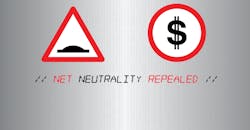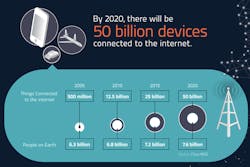The IoT Should Fear the End of Net Neutrality
The Internet of Things has been in thriving over the past few years. According to the Boston Consulting Group market analysis “Winning In IoT, It’s All About The Business Processes,” by 2020, $267 billion will be spent on IoT technologies, products, and services. The greatest market sources of revenue will come from services and IoT applications investments.
The compound annual growth rate till 2020 for all revenue layers of the IoT technology has been, and forecast to continue at, 20%. We are finally looking at the widespread adoption of IoT, especially at the industrial level. Therefore, my concern is how will the repeal of net neutrality affect its growth.
There are two schools of thought when it comes to net neutrality. Recently, Stuart Carlaw, Chief Research Officer at ABI Research, expressed his opinions about the repeal. “The repeal of the net neutrality legislation will enable the communications industry to work within the bounds of a more natural market condition. It will allow those companies that are burdened with the massive expense of rolling out new networks to support 5G (both fixed and wireless) and IoT solutions to be able to generate sufficient revenues to justify investment.”
’Net Profits
The repeal of net neutrality allows internet service providers (ISPs) to not only scale service, but also possibly provide priority access to those who pay for a premium. Essentially, by letting companies invest more money for better internet services, they can expand their IoT services quicker. Carlaw also states “if anything, this legislative move will likely provide the much-needed boost to timelines for more meaningful technological deployments that will enable companies to transform digitally and allow consumers to benefit from technology-driven improvements in service from multiple industry segments based on best-of-breed communications.”
While this new possible internet market does allow for those willing to pour more money into faster and dedicated services, it naturally restricts access to internet pipelines to the wealthiest of companies.
Net neutrality does not just cover internet access. Besides preventing ISPs from creating “fast lanes” or “slow lanes” for dedicated or competing services, respectively, it also protects device access to the internet. Currently, an ISP cannot limit the number of devices you connect to your internet or charge you extra for using a Wi-Fi router. If the repeal of net neutrality becomes law, ISPs could start charging consumers and companies for every device connected to its network.
Comcast, for example, is already working on producing its own smart-home device platform. Without net neutrality, nothing prevents the company from prioritizing network access to its devices over competitors like Apple or Google. This forces consumers to choose between buying Comcast devices or paying for higher internet packages to ensure that their competitor smart-home products perform adequately.
Several research firms like Gartner and Visual Capitalist predict IoT devices to reach 50 billion by 2020. (Courtesy of Visual Capitalist)
An IoT Game-Changer?
Connected devices form the heart of IoT. Companies are installing sensors and decentralized servers to connect to cloud-based analytics and storage for their infrastructure. With the rise of IoT, more devices depend on wireless connections. For the time being, many devices can stay within their own organization’s wireless intranet. However, as companies expand globally and scale up their IoT services, they will rely on internet access to communicate with different job sites.
Former FCC chair Tom Wheeler ushered in the agency's net neutrality rules back in 2015. Then, the rules of net neutrality were considered essential to the growth and innovation of IoT in the U.S. He now sits on the board of IoT software company Actility. Recently, Wheeler spoke with Wired.com and pointed out that even if the majority of the data moves across a private network, interference from an ISP is possible if that data were to transmit over the public internet.
"Latency, as computers are talking to computers, becomes a very important thing. The reality is that I need to know that information with low latency,” says Wheeler. If an alert needs to be sent to a mobile device, that data has to be sent over the internet. He continues, “The question becomes whether there will be different levels of service, will there be paid prioritization?”
This is what troubles me about the repeal of net neutrality. For consumers, it will become another service they will need to negotiate, just as many do today in regards to their cable service—upgrading or downgrading on different cable packages based on price.
However, IoT devices and networks are poised to infiltrate every aspect of our lives, not just smart homes, but hospitals, schools, and infrastructure. How will that information be treated by ISPs? What gets priority? Which hospitals get to send out their information faster—public or private? Which smart cars will connect to a city’s IoT network quicker? What education systems get faster internet access to teach the engineers of tomorrow—the private school system or the public education system? Net neutrality at least ensured that no matter who was accessing the internet, it was fair to anyone that tried.


